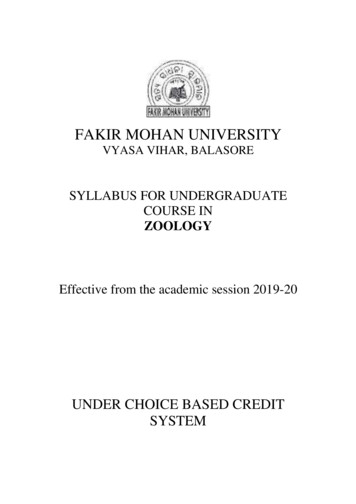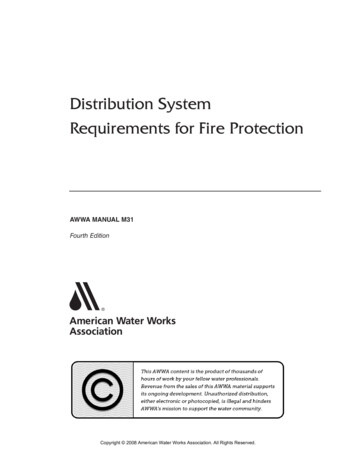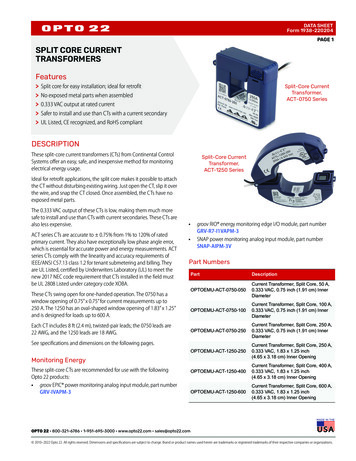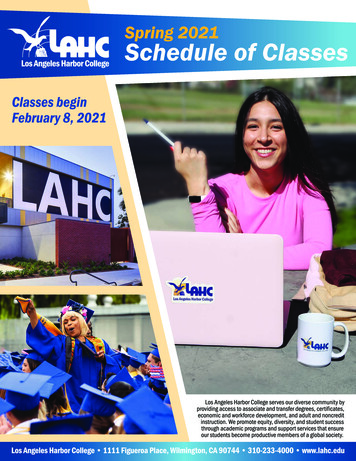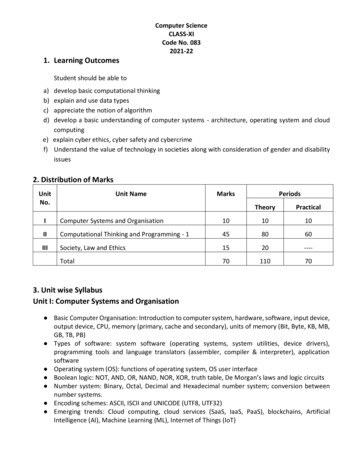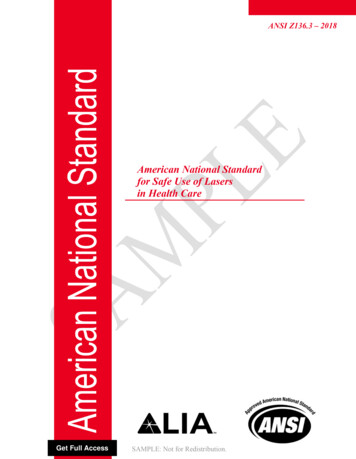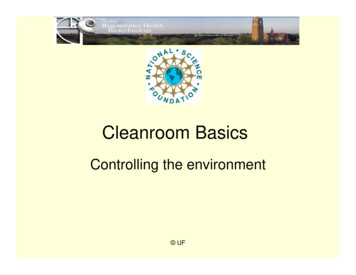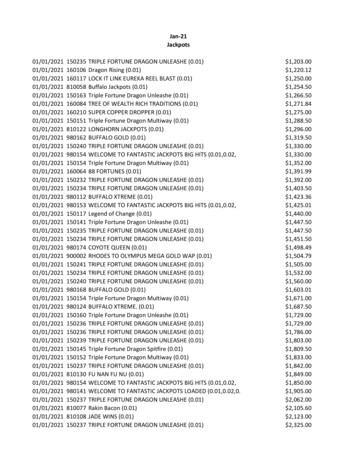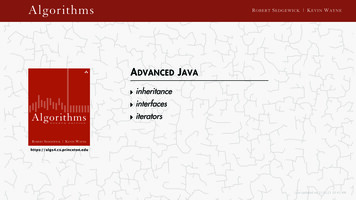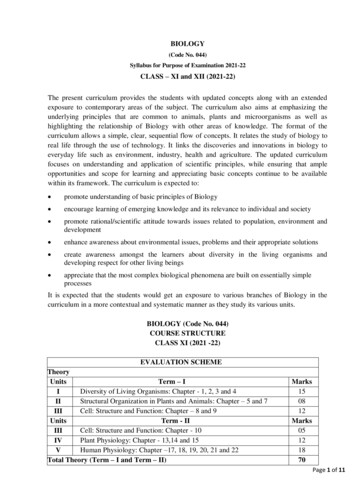
Transcription
BIOLOGY(Code No. 044)Syllabus for Purpose of Examination 2021-22CLASS – XI and XII (2021-22)The present curriculum provides the students with updated concepts along with an extendedexposure to contemporary areas of the subject. The curriculum also aims at emphasizing theunderlying principles that are common to animals, plants and microorganisms as well ashighlighting the relationship of Biology with other areas of knowledge. The format of thecurriculum allows a simple, clear, sequential flow of concepts. It relates the study of biology toreal life through the use of technology. It links the discoveries and innovations in biology toeveryday life such as environment, industry, health and agriculture. The updated curriculumfocuses on understanding and application of scientific principles, while ensuring that ampleopportunities and scope for learning and appreciating basic concepts continue to be availablewithin its framework. The curriculum is expected to: promote understanding of basic principles of Biology encourage learning of emerging knowledge and its relevance to individual and society promote rational/scientific attitude towards issues related to population, environment anddevelopment enhance awareness about environmental issues, problems and their appropriate solutions create awareness amongst the learners about diversity in the living organisms anddeveloping respect for other living beings appreciate that the most complex biological phenomena are built on essentially simpleprocessesIt is expected that the students would get an exposure to various branches of Biology in thecurriculum in a more contextual and systematic manner as they study its various units.BIOLOGY (Code No. 044)COURSE STRUCTURECLASS XI (2021 -22)EVALUATION SCHEMETheoryUnitsTerm – IDiversity of Living Organisms: Chapter - 1, 2, 3 and 4IStructural Organization in Plants and Animals: Chapter – 5 and 7IICell: Structure and Function: Chapter – 8 and 9IIIUnitsTerm - IICell: Structure and Function: Chapter - 10IIIPlant Physiology: Chapter - 13,14 and 15IVHuman Physiology: Chapter –17, 18, 19, 20, 21 and 22VTotal Theory (Term – I and Term – II)Marks150812Marks05121870Page 1 of 11
Practicals Term – IPracticals Term – IITotal1515100THEORYTerm – IUnit-I Diversity of Living OrganismsChapter-1: The Living WorldWhat is living? Biodiversity; Need for classification; three domains of life; concept of speciesand taxonomical hierarchy; binomial nomenclature.Chapter-2: Biological ClassificationFive kingdom classification; Salient features and classification of Monera, Protista and Fungiinto major groups; Lichens, Viruses and Viroids.Chapter-3: Plant KingdomSalient features and classification of plants into major groups - Algae, Bryophyta, Pteridophytaand Gymnospermae. (salient and distinguishing features and a few examples of each category).Chapter-4: Animal KingdomSalient features and classification of animals, non-chordates up to phyla level and chordates upto class level (salient features and distinguishing features of a few examples of each category).(No live animals or specimen should be displayed.)Unit-II Structural Organization in Animals and PlantsChapter-5: Morphology of Flowering PlantsMorphology of inflorescence and flower, Description of 01 family: Solanaceae or Liliaceae (tobe dealt along with the relevant experiments of the Practical Syllabus).Chapter-7: Structural Organization in AnimalsAnimal tissues.Unit-III Cell: Structure and FunctionChapter-8: Cell-The Unit of LifeCell theory and cell as the basic unit of life, structure of prokaryotic and eukaryotic cells; Plantcell and animal cell; cell envelope; cell membrane, cell wall; cell organelles - structure andfunction; endomembrane system, endoplasmic reticulum, golgi bodies, lysosomes, vacuoles,mitochondria, ribosomes, plastids, microbodies; cytoskeleton, cilia, flagella, centrioles(ultrastructure and function); nucleus.Chapter-9: BiomoleculesChemical constituents of living cells: biomolecules, structure and function of proteins,Page 2 of 11
carbohydrates, lipids, nucleic acids; Enzymes- types, properties, enzyme action.Term – IIUnit-III Cell: Structure and FunctionChapter-10: Cell Cycle and Cell DivisionCell cycle, mitosis, meiosis and their significanceUnit-IV Plant PhysiologyChapter-13: Photosynthesis in Higher PlantsPhotosynthesis as a means of autotrophic nutrition; site of photosynthesis, pigments involved inphotosynthesis (elementary idea); photochemical and biosynthetic phases of photosynthesis;cyclic and non-cyclic photophosphorylation; chemiosmotic hypothesis; photorespiration; C3 andC4 pathways; factors affecting photosynthesis.Chapter-14: Respiration in PlantsExchange of gases; cellular respiration - glycolysis, fermentation (anaerobic), TCA cycle andelectron transport system (aerobic); energy relations - number of ATP molecules generated;amphibolic pathways; respiratory quotient.Chapter-15: Plant - Growth and DevelopmentGrowth regulators - auxin, gibberellin, cytokinin, ethylene, ABA.Unit-V Human PhysiologyChapter-17: Breathing and Exchange of GasesRespiratory organs in animals (recall only); Respiratory system in humans; mechanism ofbreathing and its regulation in humans - exchange of gases, transport of gases and regulation ofrespiration, respiratory volume; disorders related to respiration - asthma, emphysema,occupational respiratory disorders.Chapter-18: Body Fluids and CirculationComposition of blood, blood groups, coagulation of blood; composition of lymph and itsfunction; human circulatory system - Structure of human heart and blood vessels; cardiac cycle,cardiac output, ECG; double circulation; regulation of cardiac activity; disorders of circulatorysystem - hypertension, coronary artery disease, angina pectoris, heart failure.Chapter-19: Excretory Products and their EliminationModes of excretion - ammonotelism, ureotelism, uricotelism; human excretory system –structure and function; urine formation, osmoregulation; regulation of kidney function - renin angiotensin, atrial natriuretic factor, ADH and diabetes insipidus; role of other organs inPage 3 of 11
excretion; disorders - uremia, renal failure, renal calculi, nephritis; dialysis and artificial kidney,kidney transplant.Chapter-20: Locomotion and MovementSkeletal muscle, contractile proteins and muscle contraction.Chapter-21: Neural Control and CoordinationNeuron and nerves; Nervous system in humans - central nervous system; peripheral nervoussystem and visceral nervous system; generation and conduction of nerve impulse.Chapter-22: Chemical Coordination and IntegrationEndocrine glands and hormones; human endocrine system - hypothalamus, pituitary, pineal,thyroid, parathyroid, adrenal, pancreas, gonads; mechanism of hormone action (elementary idea);role of hormones as messengers and regulators, hypo - and hyperactivity and related disorders;dwarfism, acromegaly, cretinism, goiter, exophthalmic goiter, diabetes, Addison's disease.Note: Diseases related to all the human physiological systems to be taught in brief.PRACTICALSMax. Marks: 15 for each TermEvaluation SchemeTERM-ITERM - IIPart AOne Major ExperimentExperiment No. - 1Experiment No. –3, 4One Minor ExperimentExperiment No. - 2Experiment No. - 5, 6, 7Part BSpottingB.1, 2, 3B.4, 5(3 Spots of 1 mark each)Practical Record Investigatory Project& Record Viva VoceTotalMARKS433515Practicals should be conducted alongside the concepts taught in theory classes.A: List of ExperimentsTERM -I:1. Study and describe a locally available common flowering plant, from any one family:Solanaceae or Liliaceae (Poaceae, Asteraceae or Brassicaceae can be substituted in caseof particular geographical location) including dissection and display of floral whorls,anther and ovary to show number of chambers (floral formulae and floral diagrams).2. Study of osmosis by Potato osmometer.TERM -II:Page 4 of 11
3.4.5.6.7.Separation of plant pigments through paper chromatography.Study of distribution of stomata in the upper and lower surfaces of leaves.Study of the rate of respiration in flower buds/leaf tissue and germinating seeds.Test for presence of sugar in urine.Test for presence of albumin in urine.B. Study/Observation of the following (spotting):TERM - I:B.1 Parts of a compound microscope.B.2 Specimens/slides/models and identification with reasons - Bacteria, Oscillatoria,Spirogyra, Rhizopus, mushroom, yeast, liverwort, moss, fern, pine, onemonocotyledonous plant, one dicotyledonous plant and one lichen.B.3 Virtual specimens/slides/models and identifying features of - Amoeba, Hydra,liverfluke,Ascaris, leech, earthworm, prawn, silkworm, honeybee, snail, starfish, shark, rohu, frog,lizard, pigeon and rabbit.TERM- II :B.4 Tissues and diversity in shape and size of animal cells (squamous epithelium, smooth,skeletal and cardiac muscle fibers and mammalian blood smear) throughtemporary/permanent slides.B.5 Mitosis in onion root tip cells and animal cells (grasshopper) from permanent slides.Practical Examination for Visually Impaired Students Class XINote: The ‘Evaluation schemes’ and ‘General Guidelines’ for visually impaired students asgiven for Class XII may be followed.Practicals should be conducted alongside the concepts taught in theory classes.A. Items for Identification/Familiarity with the apparatus /equipments/animal and plantmaterial / chemicals etc. for assessment in practicals (All experiments)TERM - I: Plants of Solanaceae - Brinjal, Petunia, any other or Liliaceae- Any of the Lilies.Compound microscope, Test tube, Petridish, Beaker, Scalpel.TERM - II: Mushroom, Succulents such as Aloe vera/Kalanchoe, Raisins, Potatoes.Honey comb, Mollusc shell, Model of cockroach, Pigeon and Star fish.Chromatography paper, Chromatography chamber, Alcohol.B. List of Practicals:TERM - I:1. Study one locally available common flowering plants of the family – Solanaceae orLiliaceae and identify inflorescence/flower.2. Study the parts of a compound microscope- eye piece and objective lens, mirror, stage,coarse and fine adjustment knobs.TERM - II:Page 5 of 11
3. Identify the given specimen of a fungus – Mushroom, gymnosperm- pine cone4. Study honey-bee/butterfly, snail shell, Starfish, Pigeon (through models).Note: The above practicals may be carried out in an experiential manner rather than recordingobservations.Prescribed Books:1. Biology Class-XI, Published by NCERT2. Other related books and manuals brought out by NCERT (including multimedia)BIOLOGY(Code No. 044)COURSE STRUCTURECLASS XII (2021 - 22)EVALUATION SCHEMETheoryUnitsTerm – IReproduction: Chapter - 2, 3 and 4VIGenetics and Evolution: Chapter – 5 and 6VIIUnitsTerm - IIBiology and Human Welfare: Chapter – 8 and 10VIIIBiotechnology and its Applications: Chapter – 11 and 12IXEcology and Environment: Chapter – 13 and 15XTotal Theory (Term – I and Term – II)Practicals Term – IPracticals Term – IITotalMarks1520Marks141110701515100THEORYTERM - IUnit-VI ReproductionChapter-2: Sexual Reproduction in Flowering PlantsFlower structure; development of male and female gametophytes; pollination - types, agenciesand examples; outbreeding devices; pollen-pistil interaction; double fertilization; postfertilization events - development of endosperm and embryo, development of seed and formationof fruit; special modes- apomixis, parthenocarpy, polyembryony; Significance of seed dispersaland fruit formation.Chapter-3: Human ReproductionPage 6 of 11
Male and female reproductive systems; microscopic anatomy of testis and ovary; gametogenesis- spermatogenesis and oogenesis; menstrual cycle; fertilisation, embryo development uptoblastocyst formation, implantation; pregnancy and placenta formation (elementary idea);parturition (elementary idea); lactation (elementary idea).Chapter-4: Reproductive HealthNeed for reproductive health and prevention of Sexually Transmitted Diseases (STDs); birthcontrol - need and methods, contraception and medical termination of pregnancy (MTP);amniocentesis; infertility and assisted reproductive technologies - IVF, ZIFT, GIFT (elementaryidea for general awareness).Unit-VII Genetics and EvolutionChapter-5: Principles of Inheritance and VariationHeredity and variation: Mendelian inheritance; deviations from Mendelism – incompletedominance, co-dominance, multiple alleles and inheritance of blood groups, pleiotropy;elementary idea of polygenic inheritance; chromosome theory of inheritance; chromosomes andgenes; Sex determination - in human being, birds and honey bee; linkage and crossing over; sexlinked inheritance - haemophilia, colour blindness; Mendelian disorders in humans -thalassemia;chromosomal disorders in humans; Down's syndrome, Turner's and Klinefelter's syndromes.Chapter-6: Molecular Basis of InheritanceSearch for genetic material and DNA as genetic material; Structure of DNA and RNA; DNApackaging; DNA replication; Central Dogma; transcription, genetic code, translation; geneexpression and regulation - lac operon; Genome, Human and rice genome projects; DNAfingerprinting.TERM - IIUnit-VIII Biology and Human WelfareChapter-8: Human Health and DiseasesPathogens; parasites causing human diseases (malaria, dengue, chikungunya, filariasis,ascariasis, typhoid, pneumonia, common cold, amoebiasis, ring worm) and their control; Basicconcepts of immunology - vaccines; cancer, HIV and AIDS; Adolescence - drug and alcoholabuse.Chapter-10: Microbes in Human WelfareMicrobes in food processing, industrial production, sewage treatment, energy generation andmicrobes as bio-control agents and bio-fertilizers. Antibiotics; production and judicious use.Unit-IX Biotechnology and its ApplicationsChapter-11: Biotechnology - Principles and ProcessesGenetic Engineering (Recombinant DNA Technology).Page 7 of 11
Chapter-12: Biotechnology and its ApplicationApplication of biotechnology in health and agriculture: Human insulin and vaccine production,stem cell technology, gene therapy; genetically modified organisms - Bt crops; transgenicanimals; biosafety issues, biopiracy and patents.Unit-X Ecology and EnvironmentChapter-13: Organisms and PopulationsOrganisms and environment: Habitat and niche, population and ecological adaptations;population interactions - mutualism, competition, predation, parasitism; population attributes growth, birth rate and death rate, age distribution.Chapter-15: Biodiversity and its ConservationBiodiversity - Concept, patterns, importance; loss of biodiversity; biodiversity conservation;hotspots, endangered organisms, extinction, Red Data Book, Sacred Groves, biosphere reserves,national parks, wildlife, sanctuaries and Ramsar sites.PRACTICALSMax. Marks: 15 for each TermEvaluation SchemeTERM - IPart AOne Major ExperimentOne Minor ExperimentExperiment No. – 1Experiment No. - 2TERM - IIExperiment No. - 3Experiment No. – 4, 5MARKS43Part BSpottingB.1, 2, 3, 4, 5B.6, 7, 8(3 Spots of 1 mark each)Practical Record Investigatory Project &Record Viva Voce3Total155Practicals should be conducted alongside the concepts taught in theory classes.A. List of ExperimentsTERM - I:1. Isolate DNA from available plant material such as spinach, green pea seeds, papaya, etc.2. Prepare a temporary mount to observe pollen germination.TERM - II:3. Prepare a temporary mount of onion root tip to study mitosis.4. Collect water from two different water bodies around you and study them for pH, clarity andpresence of any living organism5. Collect and study soil from at least two different sites and study them for texture, moisturecontent, pH and water holding capacity. Correlate with the kinds of plants found in them.Page 8 of 11
B. Study/observation of the following (Spotting)TERM - I:B.1 Flowers adapted to pollination by different agencies (wind, insects, birds).B.2 Identification of stages of gamete development, i.e., T.S. of testis and T.S. of ovary throughpermanent slides (from grasshopper/mice).B.3 Meiosis in onion bud cell or grasshopper testis through permanent slides.B.4 T.S. of blastula through permanent slides (Mammalian).B.5 Prepared pedigree charts of any one of the genetic traits such as rolling of tongue, bloodgroups, ear lobes, widow's peak and colourblindness.TERM – II:B.6 Common disease - causing organisms like Ascaris, Entamoeba, Plasmodium, any funguscausing ringworm through permanent slides, models or virtual images. Comment onsymptoms of diseases that they cause.B.7 Two plants and two animals (models/virtual images) found in xeric conditions. Commentupon their morphological adaptations.B.8 Two plants and two animals (models/virtual images) found in aquatic conditions. Commentupon their morphological adaptations.Practical Examination for Visually Impaired Students of Classes XI and XIIEvaluation SchemeMax. Marks: 15 for each TermTopicIdentification/Familiarity with the apparatusWritten test (Based on given/prescribed practicals)Practical Records and VivaTotalMarks55515General Guidelines The practical examination will be of one-hour duration. The written examination in practicals for these students will be conducted at the time ofpractical examination of all other students. The written test will be of 30 minutes duration. The question paper given to the students should be legibly typed. It should contain a totalof 8 practical skill based very short answer type questions. A student would be requiredto answer any 5 questions. A writer may be allowed to such students as per CBSE examination rules. All questions included in the question paper should be related to the listed practicals.Every question should require about two minutes to be answered. These students are also required to maintain a practical file. A student is expected torecord the listed experiments Term -wise as per the specific instructions for each subject.These practicals should be duly checked and signed by the internal examiner. The format of writing any experiment in the practical file should include aim, apparatusPage 9 of 11
required, simple theory, procedure, related practical skills, precautions etc.Questions may be generated jointly by the external/internal examiners and used forassessment.The viva questions may include questions based on basic cals required, procedure, precautions, sources of error etc.Class XIIPracticals should be conducted alongside the concepts taught in theory classes.A. Items for Identification/ familiarity with the apparatus for assessment in practicals (Allexperiments)TERM -I: Beaker, flask, petri plates, test tubes, aluminium foil, paint brush, bunsen burner/spiritlamp/water bath. Starch solution, iodine, ice cubes. Developmental stages of frog highlighting morula and blastula.TERM -II: Soil from different sites- sandy, clayey, loamy; Small potted plants, Cactus/Opuntia (model),Large flowers, Maize inflorescence. Model of AscarisB. List of PracticalsTERM -I:1. Study of flowers adapted to pollination by different agencies (wind, insects).2. Identification of T.S of morula or blastula of frog (model).3. Preparation of pedigree charts of genetic traits such as rolling of tongue, colour blindness.TERM -II:4. Study of the soil obtained from at least two different sites for their texture.5. Identify common disease-causing organisms like Ascaris (Model) and learn somecommon symptoms of the disease that they cause.6. Comment upon the morphological adaptations of plants found in xerophytic conditions.Note: The above practicals may be carried out in an experiential manner rather than recordingobservations.Prescribed Books:1.Biology, Class-XII, Published by NCERT2.Other related books and manuals brought out by NCERT (including multimedia)3.Biology Supplementary Material (Revised). Available on CBSE website.Page 10 of 11
Assessment Areas (Theory) 2021-22Class XIIBiology (044)CompetenciesDemonstrate Knowledge and Understanding50%Application of Knowledge / Concepts30%Analyse, Evaluate and Create20%Note: Internal choice would be provided.Suggestive verbs for various competencies Demonstrate, Knowledge and UnderstandingState, name, list, identify, define, suggest, describe, outline, summarize, etc. Application of Knowledge/ConceptsCalculate, illustrate, show, adapt, explain, distinguish, etc. Analyze, Evaluate and CreateInterpret, analyse, compare, contrast, examine, evaluate, discuss, construct, etc.Page 11 of 11
Biology Class-XI, Published by NCERT 2. Other related books and manuals brought out by NCERT (including multimedia) BIOLOGY (Code No. 044) COURSE STRUCTURE CLASS XII (2021 - 22) EVALUATION SCHEME Theory Units Term – I Marks VI Reproduction: Chapter - 2, 3 and 4 15 VII Genetics


